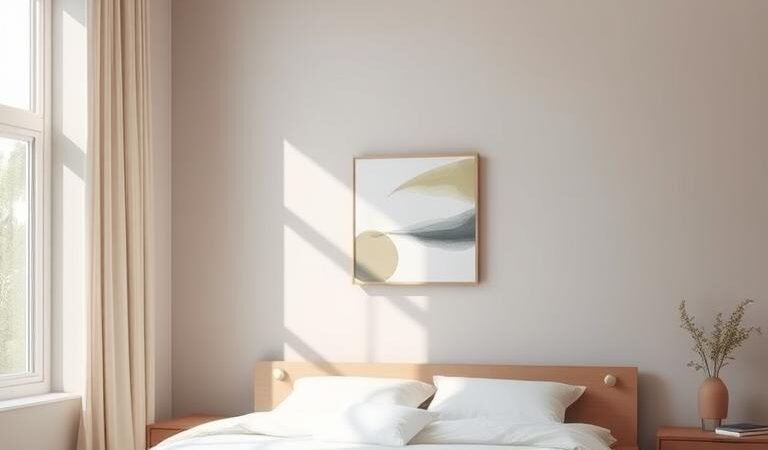A well-designed space can transform your daily life, offering both comfort and clarity. By focusing on essential elements, you create an environment that promotes relaxation and mental ease. Designers like Marie Flanigan and Elaine Santos emphasize how intentional choices in decor lead to deeper rest.
Clean lines, neutral tones, and thoughtful organization help craft a peaceful retreat. Whether working with a small area or a spacious layout, balance is key. Functional beauty shines when every piece serves a purpose while enhancing visual harmony.
Soft textures, layered lighting, and open layouts contribute to a soothing atmosphere. This approach isn’t just about aesthetics—it supports better sleep and reduces stress. Let’s explore how simplicity can elevate your personal haven.
Key Takeaways
- Simple design fosters relaxation and mental clarity.
- Neutral colors and clean lines create a calming effect.
- Expert designers prioritize both function and beauty.
- Thoughtful lighting enhances the mood of any space.
- Decluttering leads to a more restful environment.
Introduction to Minimalist Bedroom Design
A tranquil retreat starts with thoughtful design choices that embrace simplicity. This approach blends cultural wisdom—like Swedish lagom (balance) and Japanese wabi-sabi (imperfect beauty)—to create spaces that feel both intentional and inviting. Designer Rushda Hakim notes, “Your bedroom should be your sanctuary to unwind.”
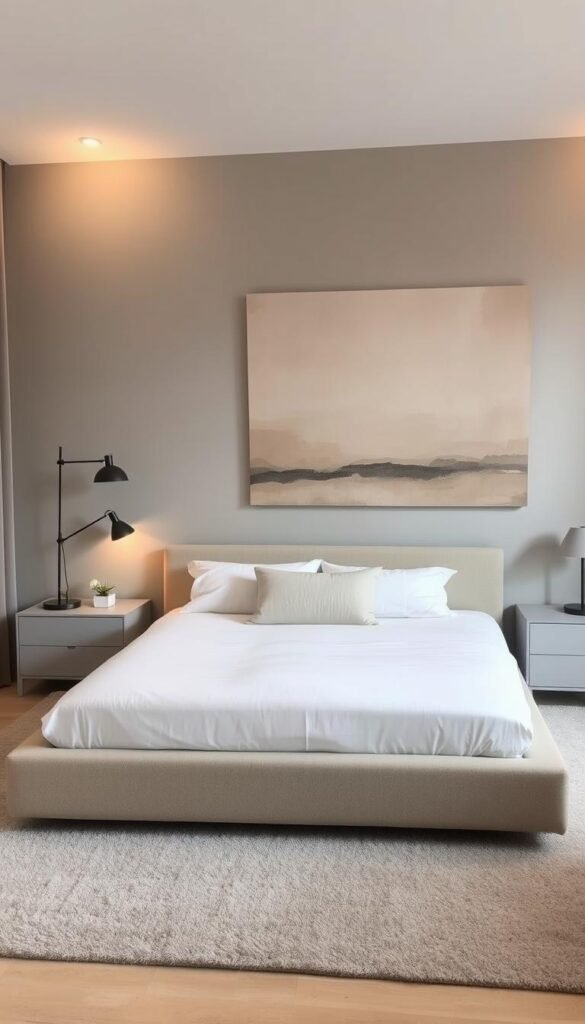
What Defines a Minimalist Bedroom?
Minimalism thrives on three principles: intentional emptiness, quality craftsmanship, and emotional resonance. It avoids excess, focusing instead on pieces that serve a purpose while evoking calm. For example, Elaine Santos’ high-ceiling designs use open layouts to amplify mental clarity.
Benefits of a Minimalist Bedroom
Research shows clutter-free environments reduce cortisol levels by 17% and help people fall asleep 29% faster. Key advantages include:
- Improved sleep: Fewer distractions mean deeper rest.
- Reduced stress: Visual calm lowers anxiety.
- Enhanced focus: Clean lines direct attention to what matters.
| Feature | Minimalist | Maximalist |
|---|---|---|
| Furniture | Low-profile, multifunctional | Ornate, statement pieces |
| Color Palette | Neutrals with subtle accents | Bold, layered hues |
| Mood | Serene and spacious | Energetic and cozy |
Whether you prefer Krista Hermanson’s “snuggle spots” or streamlined aesthetics, the goal is the same: a space that reflects your needs without overwhelm.
Core Principles of Minimalist Design
Great design thrives on purpose—every element should serve a need while creating harmony. This philosophy shapes minimalist spaces, where simplicity and functionality reign. Designers like Marie Flanigan use low-profile furniture to craft visual calm, proving that less can indeed feel like more.

Simplicity: The Heart of Minimalism
Simplicity anchors minimalist design, but it’s not about starkness. Studio Diaa’s whitewashed pine walls add texture without chaos, while Joshua McHugh’s tall ceilings emphasize airy openness. The goal? A room that feels curated, not empty.
Functionality Over Excess
Every piece must serve a purpose. The Brownstone Boys’ sculptural bed doubles as art, and Kristin Fine’s lucite nightstands exemplify the “invisible furniture” trend—functionality disguised as air. Eddie Maestri’s bed nook concept turns a small space into a focal point with smart design.
Clutter-Free Living
Clutter-free living boosts focus and peace. Try the 5/5/5 method:
- 5 minutes of daily tidying
- 5 categories decluttered weekly
- 5 zones refreshed monthly
For inspiration, explore theseminimalist bedroom design ideasthat balance aesthetics and practicality.
Choosing the Right Color Palette
Color sets the mood—your palette shapes the entire atmosphere of your space. Designers like Elisa Baran use limewash techniques to add texture, while Lisa Tharp’s bold teal-and-oxblood combinations prove accents can be daring yet balanced. Whether you crave serenity or subtle energy, the right hues tell your story.
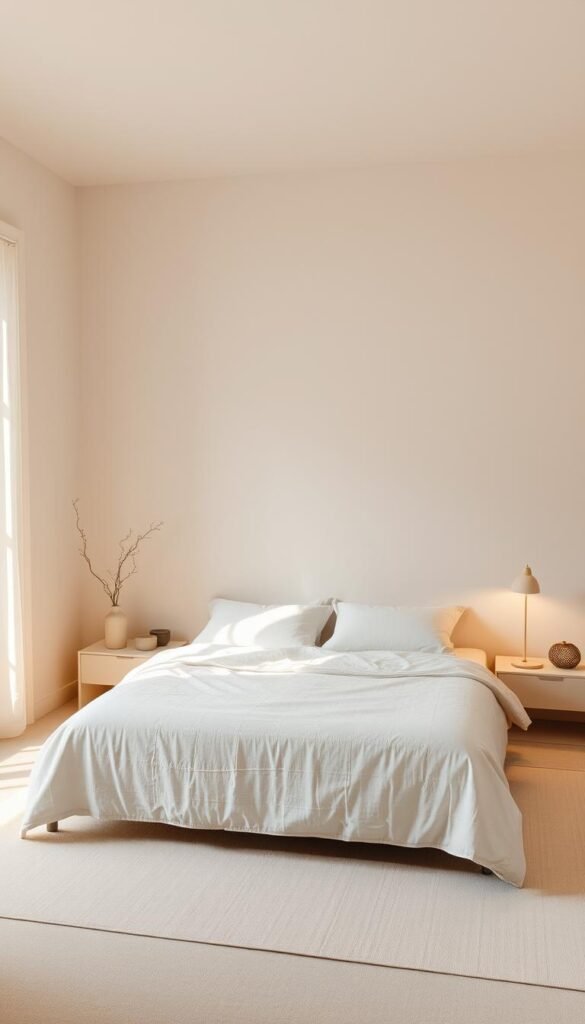
Neutral Foundations: White, Beige, and Gray
Cool vs. warm neutrals change a room’s vibe. Jessica Nelson pairs walnut nightstands with warm beige walls, while Sarah Solis’ mirror-filled spaces amplify white’s airy effect. For depth, Casa Marcelo accents beige with pampas grass—soft and sophisticated.
Accent Colors: Pastels and Earth Tones
Ezz Wilson’s rust-orange bedding demonstrates color zoning—focal points without clutter. Wendy Labrum’s taupe gingham walls add rhythm, and earthy terracottas (like JH Wall Paints’ limewash) invite tactile warmth. Pastels, such as powdery blues, keep accents gentle.
| Neutral Type | Effect | Pairing Tip |
|---|---|---|
| White | Expands space | Layer with mirrors |
| Beige | Adds warmth | Use natural textures |
| Gray | Modern calm | Mix with metallics |
DIY texture tip: Elisa Baran’s limewash requires three steps—prime, apply with a brush, and soften edges with a cloth. The result? Walls that feel organic and alive.
Essential Furniture for a Minimalist Bedroom
Furniture choices define the soul of a minimalist space, blending form and function effortlessly. Each piece should embody clean lines and intentional design, like Fiona Lynch’s headboard-free linen bed—a study in understated elegance.
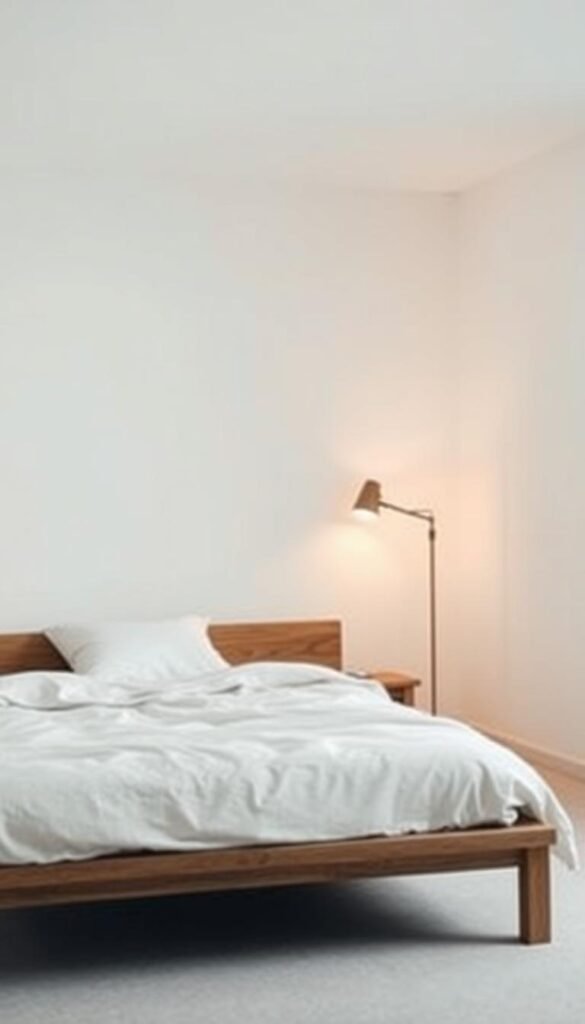
Platform Beds and Low-Profile Frames
Platform beds anchor the room with grounded simplicity. Luis Laplace’s stained oak four-poster doubles as a spatial shelf, while tatami mats offer a floor-hugging alternative. Compare options:
- Material matters: Kiln-dried walnut adds warmth; powder-coated steel feels modern.
- Storage solutions: 3-in-1 hydraulic lift beds maximize small spaces.
- Design cohesion: Marie Flanigan pairs matching wood finishes for seamless flow.
Floating Nightstands and Streamlined Dressers
Kristin Fine’s acrylic nightstands embody the “invisible furniture” trend—lightweight yet functional. For dressers, consider:
| Style | Pros | Best For |
|---|---|---|
| Open shelving | Airy feel, easy access | Small rooms |
| Hidden compartments | Clutter-free surfaces | Maximal storage needs |
A bed frame with built-in drawers or a floating nightstand keeps surfaces clear, proving that smart design elevates daily life.
Maximizing Space with Smart Storage
Smart storage transforms tight spaces into organized retreats. By integrating hidden compartments and multifunctional furniture, even the smallest rooms feel spacious. Designers like Studio Plow prove that creativity beats square footage.
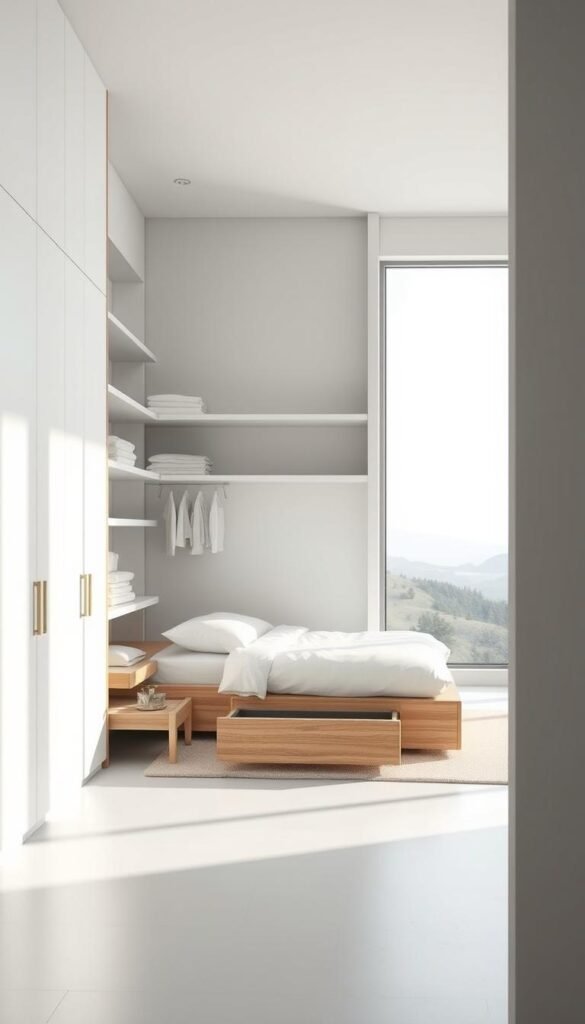
Under-Bed Storage Solutions
Under-bed storage reclaims wasted space effortlessly. Compare mechanisms:
- Roll-out drawers: Ideal for frequent access (e.g., Studio Plow’s San Francisco townhouse).
- Lift-up platforms: Best for bulky items like seasonal bedding.
JLoom’s woven baskets add texture while hiding off-season textiles—no clutter, just calm.
Built-In Wardrobes and Hidden Storage
Maison Amarande’s symmetrical closets turn walls into streamlined storage. For DIYers, IKEA PAX systems with cane fronts mimic high-end designs. Recessed bedside cubbies (like medicine cabinets) keep essentials invisible yet accessible.
Pro tip: Ladder-accessible nooks utilize vertical space—perfect for spare blankets or books. Custom California closets with pull-down rods maximize every inch.
Lighting: Natural and Artificial
The right lighting transforms a room from functional to magical with just a flicker. Whether it’s dawn’s soft glow or evening’s warm embrace, light shapes how your space feels. Designers like Elaine Santos use unframed landscape art to reflect natural light, while Sarah Solis’ mirrors amplify every ray.
Sheer Curtains and Skylights
Fabric choice matters. Linen curtains diffuse sunlight into a hazy glow, while silk offers sharper clarity. For night-shift workers, blackout skylight inserts (like Velux’s solar-powered shades) balance brightness and privacy.
Victoria Ninette’s frosted globe chandeliers pair with dimmers—ideal for adjusting ambiance. Pro tip: Place mirrors opposite windows to double natural light.
Pendant Lights and Wall Sconces
Gantri’s 3D-printed pendants merge aesthetic and innovation. For sconces, plug-in styles suit renters, while hardwired options offer cleaner lines. Circadian lighting systems (like Hue) sync with sleep cycles—cool tones for mornings, amber for evenings.
- Linen vs. silk: Linen softens; silk brightens.
- Skylight hacks: Magnetic blackout panels for flexibility.
- Sconce styles: Swing-arm for reading, uplights for drama.
Textiles and Bedding for Minimalism
Textiles shape the comfort and aesthetic of a space—soft layers invite relaxation while maintaining clean lines. From crisp percale to stonewashed linen, each fabric choice reflects intentional design. Brands like Parachute Linen and Boll & Branch prove that simplicity doesn’t sacrifice luxury.
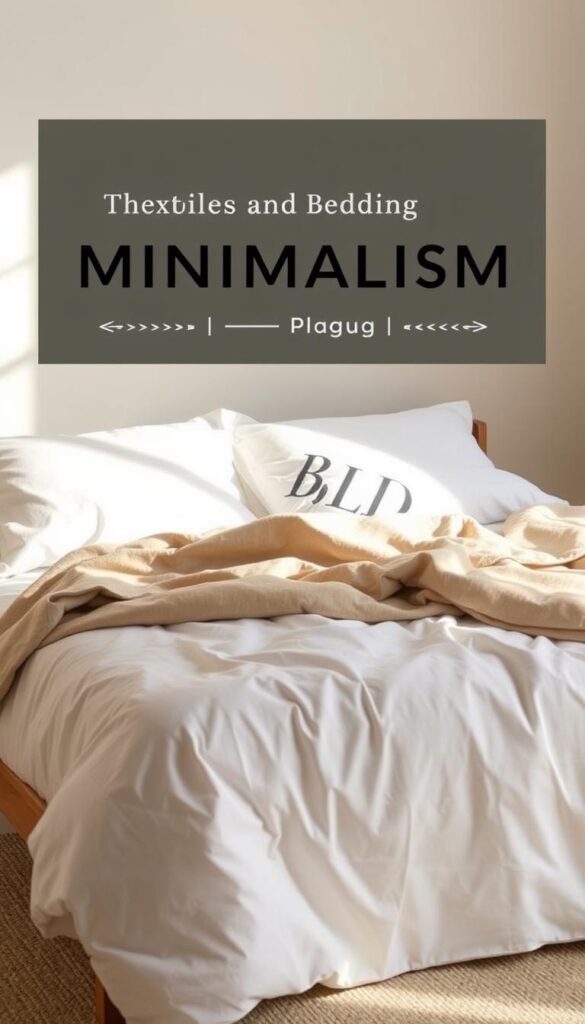
Neutral-Colored Bedding
Neutral bedding anchors the space, creating a serene backdrop. Parachute Linen’s stonewashed collection offers a lived-in feel, while Boll & Branch’s organic sateen cools skin in summer. For a cohesive look, layer shades of ivory, taupe, or slate.
| Fabric Type | Best For | Care Tip |
|---|---|---|
| Linen | Breathability, texture | Wash cold; air-dry to preserve fibers |
| Sateen | Silky smoothness | Low-heat iron to maintain sheen |
| Percale | Crisp, cool feel | Tumble dry with wool balls |
Texture-Rich Fabrics
Subtle texture adds depth without clutter. CB2’s nubby wool throws contrast smooth duvets, while matte-finish blackout curtains (lined with noise-reducing fabric) enhance sleep. For pet owners, Ruggable’s washable rugs blend practicality with design.
- Weighted blankets: Opt for glass-bead fillings—quiet and evenly distributed.
- Layering: Pair glossy silk pillows with matte linen shams for contrast.
- Rugs: Jute or flatweave styles keep lines clean underfoot.
Whether integrating a chunky knit blanket or a sleek linen duvet, focus on tactile harmony. The right textiles turn a room into a retreat—soft, inviting, and effortlessly polished.
Minimalist Wall Art and Decor
Art transforms blank walls into conversations without words. In a minimalist space, each piece should reflect personality while maintaining balance. Erin Roberts Design’s macramé fiber installations, for example, add texture without clutter—like whispers of movement frozen in time.
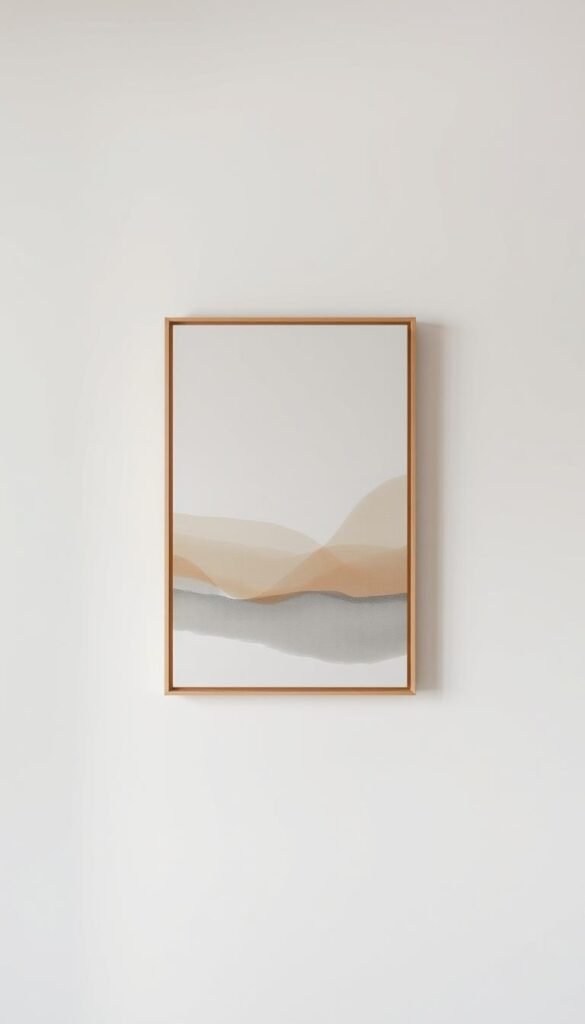
Black and White Photography
Monochrome prints anchor a room with timeless elegance. A single large-scale photograph above a bed creates visual interest, while Liz Dutton’s inward-spine book displays turn literature into sculptural decor. For cohesion, match frame materials to furniture finishes—black metal for modern, walnut for warmth.
Abstract Prints
Abstract art invites interpretation without overwhelming. Society6 offers affordable prints that blend seamlessly into minimalist style, from geometric patterns to fluid brushstrokes. Aimée Mazzenga’s gingham-drenched walls prove even bold patterns can feel serene when applied thoughtfully.
| Display Approach | Best For | Pro Tip |
|---|---|---|
| Gallery wall | Eclectic collectors | Use uniform spacing (2–3 inches between frames) |
| Statement piece | Small spaces | Center at eye level (57–60 inches from floor) |
- Floating shelves: Curate 3–5 objects with varying heights for rhythm.
- Lighting: 2700K bulbs warm cool tones; 3000K enhances whites.
- Frames: Metal feels crisp, wood adds organic softness.
Incorporating Plants into Your Space
Greenery breathes life into a room, adding vitality without clutter. Lush snake plants whisper tranquility, while ZZ plants thrive where others falter. Whether perched on floating shelves or nestled in handmade ceramic planters, plants enhance both aesthetic and air quality.

Succulents and Low-Maintenance Options
The Sill’s snake plant care protocol proves even black thumbs can succeed—water sparingly, ignore drafts. Costa Farms’ ZZ plants tolerate low light, making them ideal for dim corners. Terrain’s stoneware planters add texture with rough-hewn edges.
Soil vs. Hydroponic Systems
- Soil: Traditional but messy; opt for cactus mix for succulents.
- Hydroponic: Sleek and water-efficient—perfect for small space.
| Plant Type | Light Needs | Pet-Safe? |
|---|---|---|
| Snake Plant | Low to bright | No |
| Spider Plant | Indirect | Yes |
Self-watering pots like Lechuza’s simplify care, while vertical gardens (think mounted staghorn ferns) maximize walls. Note: NASA’s air-purification studies favor peace lilies—but they’re toxic to cats. Balance science and safety for a feel-good oasis.
Creating a Serene Minimalist Bedroom: Where Less Is More
Harmony in a space comes from balancing beauty and purpose. Amy Knerr’s Indiana molding techniques showcase how subtle architectural details—like recessed panels—add depth without overwhelming. Meanwhile, Tali Roth’s velvet coverlet proves luxury thrives in simplicity, its whisper-soft texture inviting touch.
Balancing Aesthetics and Functionality
Every element should serve a dual role. Reena Simon’s nature-inspired palette pairs linen drapes with rattan lamps, blending organic warmth with clean lines. For tactile contrast, pair smooth plaster walls with a chunky knit throw—visual rest meets cozy comfort.
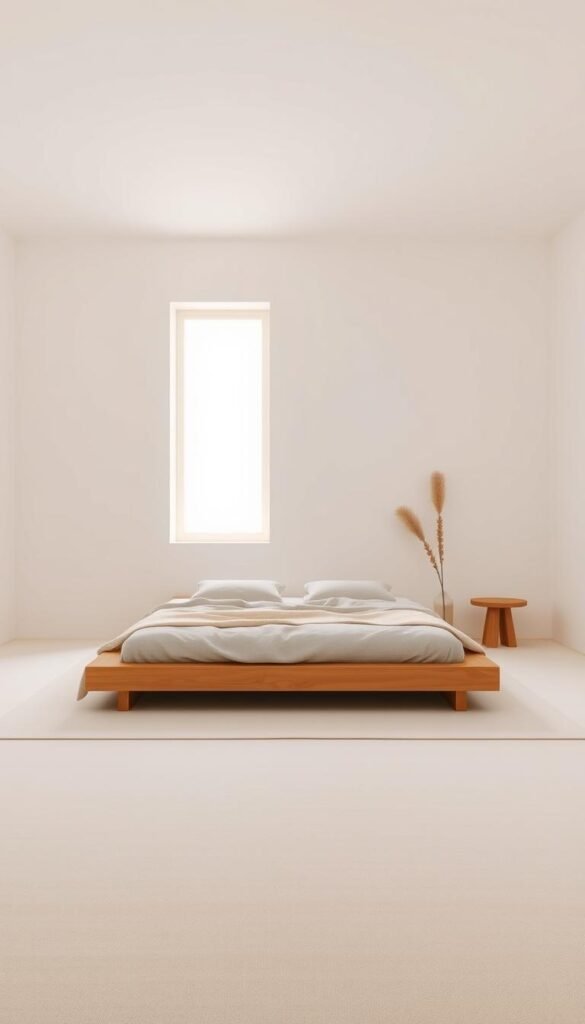
Smart integrations keep tech invisible. Hide routers in woven baskets or use recessed outlets for charging stations. Negative space ratios matter too: aim for 30% open wall area to let the design breathe.
Personalizing Without Clutter
Heirlooms deserve spotlight, not storage. Display a single vintage mirror atop a floating shelf or frame handwritten notes as art. Essential oil diffusers (like Vitruvi’s stone models) add scent subtly—no bulky candles needed.
- Texture layering: Combine matte ceramics with glossy metallics.
- Vertical gardens: Mount air plants in geometric terrariums.
- Light control: Smart shades sync with sunrise for gentle wake-ups.
Whether through curated objects or hidden tech, a bedroom should reflect you—quietly. The goal? A space that feels both intentional and effortlessly lived-in.
Statement Pieces in Minimalist Design
Statement pieces elevate minimalist spaces by blending artistry with purpose. A sculptural bed frame or textured wall finish can anchor a room’s aesthetic without clutter. These elements prove that simplicity thrives on intentional boldness.
Sculptural Bed Frames
Floyd’s modular system redefines the bed frame with parametric angles and walnut veneers. Compare options:
- Live-edge designs: Rustic warmth (e.g., Vermont Woods Studios’ hemlock slabs).
- Parametric styles: Geometric precision (like B&B Italia’s aluminum frames).
Arteriors’ brass sconces complement both—artful lighting doubles as decor.
Limewash Paint and Textured Wallpaper
Portola Paints’ Roman Clay adds whisper-soft texture to walls. Cost analysis:
| Finish | Cost/Sq Ft | DIY Difficulty |
|---|---|---|
| Limewash | $2–$4 | Moderate (3-step application) |
| Venetian plaster | $5–$8 | Advanced (trowel skills needed) |
Phillip Jeffries’ grasscloth wallpaper offers removable panels—ideal for renters. Layer with matte black trim for contrast.
Focal point tip: Place statement pieces on the wall opposite the entrance. This draws the eye naturally, creating balance.
Minimalist Bedroom Layout Tips
Thoughtful arrangement creates effortless movement in any space. Maestri Studio’s Tudor bed nook demonstrates how angled walls can guide flow naturally. By prioritizing balance, you ensure each piece contributes to the room’s rhythm.
Symmetry and Flow
Hilary Walker’s mid-century modern designs use the golden ratio—a 1:1.618 spacing formula—to place furniture. Try these steps:
- Measure the room’s longest wall and multiply by 0.618 for ideal bed placement.
- Use Feng Shui’s bagua map to align the bed with the “career” or “health” zone.
- Leave 24-inch walkways between furniture for smooth movement.
Editing Visual Noise
Olympia Dumbo’s edited bedside tables prove less is more. Reduce distractions with:
| Element | Solution |
|---|---|
| Cords | Adhesive clips under nightstands |
| Clutter | Marie Kondo’s vertical folding for drawers |
| Tools | RoomSketcher app for 3D layout testing |
For visual interest, pair a single artwork with negative space. The right style feels curated, not crowded.
Warm Tones and Natural Materials
The warmth of natural materials creates an inviting atmosphere in any home. From the whisper-soft grain of white oak to the rugged charm of clay plaster, these elements add depth and character. Designers like Carl Hansen pair his iconic CH25 chair with earthy texture—proof that simplicity thrives on organic richness.
Wood Finishes and Earthy Textures
Wood anchors a space with timeless appeal. Vermont Woods Studios’ FSC-certified walnut desks showcase swirling grain patterns, while white oak’s pale hue brightens small rooms. Compare options:
| Type | Best For | Maintenance |
|---|---|---|
| Walnut | Warm, dramatic spaces | Oil monthly to prevent drying |
| White Oak | Airy, modern rooms | Water-resistant; wipe clean |
Heath Ceramics’ hand-glazed tiles introduce subtle variation—each piece slightly imperfect, like Japanese wabi-sabi. For walls, clay plaster workshops teach DIY techniques to create tactile depth with VOC-free finishes.
- Rattan lighting: Amber-toned pendants cast a honeyed glow.
- Organic cotton batting: GOTS-certified for breathable bedding.
- Textured throws: Stonewashed linen adds cozy contrast.
These elements work together to make a space feel grounded yet elegant. Whether through a live-edge headboard or hand-thrown pottery, nature’s imperfections become the ultimate luxury.
Floor-to-Ceiling Drapery for Elegance
Floor-to-ceiling curtains add instant sophistication, creating a seamless flow from wall to floor. Krista Hermanson’s cream linen installation demonstrates how drapery softens architectural edges while amplifying natural light. This approach balances grandeur with simplicity—key to minimalist elegance.
Choosing Lightweight Fabrics
Lightweight fabrics like Pottery Barn’s Belgian linen offer movement without bulk. Compare styles:
- Pinch pleat: Tailored and formal; ideal for structured looks.
- Grommet top: Modern and effortless; enhances an airy feel.
For blackout needs, Silent Gliss’s track system integrates hidden liners—no light leaks, just clean lines. Automated motors (like Somfy’s) add luxury with silent operation.
| Fabric Type | Weight (oz/sq yd) | Best For |
|---|---|---|
| Linen | 4–5 | Diffused light, casual elegance |
| Silk Voile | 3–4 | Sheer luminosity, delicate aesthetic |
Hemming tip: Floor-to-ceiling panels should kiss the floor or pool slightly (1–2 inches) for drama. Measure from the rod to the floor, then subtract ½ inch for precision.
Minimalist Bedroom Ideas for Small Spaces
Small spaces demand smart solutions—where every inch serves a purpose. Thoughtful furniture choices and vertical storage can make even the coziest nook feel expansive. These bedroom ideas prove that limitations spark creativity.
Multi-Functional Furniture
Resource Furniture’s wall beds meet ASTM safety standards with smooth-gliding mechanisms. Consider these space-savers:
- Ottoman conversions: Storage benches with lift-up seats for off-season textiles
- Narrow dressers: 18-inch deep units with full-extension drawers
IKEA’s IVAR system adapts to ceilings up to 98″ high—perfect for displaying plants or books. Fold-down desks (like Urban Outfitters’ ladder style) tuck away when not in use.
Vertical Storage Solutions
Look upward when floor space is limited. Ceiling-mounted clothing racks keep garments dust-free while adding industrial charm. Compare systems:
| Type | Weight Capacity | Best For |
|---|---|---|
| Pulley systems | 25 lbs | Seasonal items |
| Track rails | 50 lbs | Daily wardrobe |
Sliding doors save 12″ of swing space compared to hinged models. For renters, tension rods between walls create instant vertical storage without tools.
Every choice should serve multiple needs—the way to make small spaces work harder while feeling effortlessly calm.
Conclusion: Embrace the Minimalist Lifestyle
Adopting a simpler way of living reshapes how you interact with your surroundings. Inspired by Marie Kondo’s joy-sparking philosophy, it’s about cherishing what adds value—whether a well-loved chair or a sunlit corner. Start small: a 30-day decluttering challenge or weekly space audits can build lasting habits.
Digital minimalism matters too. Unsubscribe from inbox chaos, organize apps into folders, and let screens serve purpose—not distraction. Communities thrive on sharing unused items, turning excess into opportunity.
The long-term rewards? Reduced stress, sharper focus, and a deeper appreciation for your curated design. Explore minimalist design mastery to continue refining your sanctuary.
